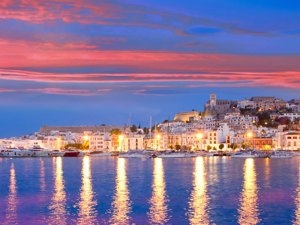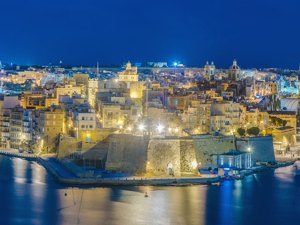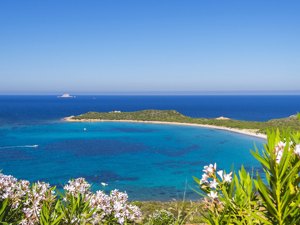Split is the largest city in the region of Dalmatia
and the second largest in Croatia in terms of inhabitant numbers.
It is a city with an ancient history: founded as a colony of Syracuse in the 3rd or 2nd century BC, it later became a Roman city when the emperor Diocletian decided in 295-304 AC to build a sumptuous palace to spend the last few years of his life.

The Diocletian’s Palace. Photo: Sisterscom.com, Shutterstock
Diocletian’s Palace and the old town of Split have been
on UNESCO’s World Heritage list since 1979
Over the years the city has developed around Diocletian’s Palace and the various stages of history are clearly visible: from ancient Rome, the Middle Ages, and up to the present day. A trip to the city reveals wonderful architecture, the Peristyle, small Romanesque churches, Gothic medieval palaces, Renaissance entrances of the houses of nobility and Baroque façades.

The seafront promenade of Split. Photo: Sisterscom.com, Shutterstock
Riva
A tour of the beautiful sights of Split might begin with the most important buildings, such as Diocletian’s Palace, as well as the heart of the city, which includes a long seafront promenade known as the Riva.
A wonderful view of the south façade of Diocletian’s Palace and the city port can be enjoyed on a walk along the Riva heading west, passing a series of bars and shops. The road then continues through several city squares, such as Voćni trg (Fruit square) and Trg Republike (Republic Square), and heads towards the well-preserved northern wall of the palace.
Here, for good luck, it is customary to touch the big toe of the foot of the large statue of Gregory of Nin, which faces the imposing Golden Gate. Through the Golden Gate lies the interior of Diocletian’s Palace. Our tour continues along old alleyways and past medieval buildings, including the narrowest lane of the city, quirkily called ‘Pusti me da prodjem’ or ‘Let me pass’ right alongside the Temple of Jupiter, which leads through the Vestibule to the Peristyle, the palace’s central square.
An Egyptian sphinx, constructed 3,500 years ago,
sits in the Peristyle, as testament to the city’s history

The Peristyle. Photo: Sisterscom.com, Shutterstock
An important example of late Roman architecture, the Peristyle is dominated by the bell tower of the Cathedral of Saint Domnius, patron saint of the city.
The cathedral is located in the ancient mausoleum of the emperor, one of the oldest Christian buildings in the world.
The underground halls of the building, once stores for the medieval city and today one of the main tourist attractions where scenes from the famous series Game of Thrones were set, lead toward the Riva.
Don’t miss a visit to the city’s central market, among the colours, flavours and perfumes of Dalmatia and the Mediterranean. From here we again enter the Palace, passing, this time, through the Silver Gate. Here the Decumanus, the principal Roman road, leads to the western gate of the palace - the Iron Gate - where the old clock tower can be found.

The historic center of Split. Photo: Sisterscom.com, Shutterstock
Ahead lies the Pjaca (People’s Square) with the historic Gothic Old Town Hall. Our walk continues towards the old fish market (120 years old) and passes along Marmontova Street toward the Prokurative, a square that closely resembles St. Mark’s Square in Venice. We then cross the old town and end with a stroll along the western part of the Riva for a break in one of the many bars.
Any further time on our hands can be spent in the pine forests of Mount Marjan, a symbol of Split, which affords a beautiful view of the city and the sea. At the foot of the southern slope is the well-known Ivan Meštrović Gallery, as well as the Kaštelet, a fortress housing other works by the famous Croatian sculptor. Don’t miss a visit to the city’s Bačvice beach, or, in the vicinity, a tour of the islands of Brač, Hvar, Šolta and Čiovo.

Dalmatian Peka filled with meat and vegetables. Photo: Sisterscom.com, Shutterstock
The cuisine of Split,
a combination of different cultures
Both the cuisine of Dalmatia and that of Split are a combination of different cuisines and cultures: Mediterranean, Venetian, Turkish and central European. Split offers the best in Dalmatian cuisine, which is personalised with local, very fresh ingredients.
Among the typical local dishes are: pasta with tomato sauce, minced meat, boiled meat with tomato sauce, lamb tripe, spit-roasted lamb, meatballs with sauce, venison stew with dumplings, steak with sauce, stuffed peppers, fish stew, seafood, crab, and excellent desserts such as rožada (caramel cake), pancakes, doughnuts, kroštule (a pastry), fritule, sirnica (Easter bread) and the Makarana cake.
Text by Nicolò Villa
Video: www.visitsplit.com
Tourism Board
www.croatia.hr
www.visitsplit.com
Partnership with Booking.com
Where to sleep in Split

Photo: Sisterscom.com, Shutterstock
Split is a welcoming city and offers various possibilities for accommodation.
To find the ideal hotel and the best offers you can do a search for the stars but also for districts or landmarks.
LANDMARKS
Hotels in tourist areas
AIRPORT
WHAT TO SEE in split
Monuments of Split

Photo: Sisterscom.com, Shutterstock
DIOCLETIAN’S PALACE
Overlooking the port, Diocletian’s Palace is a example of Roman architecture, a combination of sumptuous imperial villa and Roman military encampment. The building has a rectangular shape with four corner towers and four turrets. Built from white Brac stone, Diocletian’s Palace is a small citadel in the city consistin of two roads that cross which create four separate areas. The structure consists of over 200 buildings, houses, shops, bars and restaurants.

Photo: Sisterscom.com, Shutterstock
CATHEDRAL OF SAINT DOMNIUS
The mausoleum of the emperor Diocletian became a cathedral in the mid-seventh century and houses altars with the relics of Christian martyrs of Saint Domnius and Saint Anastasius. Inside the circular plan are circular and rectangular niches. The wooden entrance doors, inlaid by the artist Andrija Buvina in 1214, depict scenes from the Gospel. The cathedral’s bell tower, some 57 metres high, was built in the thirteenth century and is a medieval Dalmatian construction that offers a wonderful view of the city.

Photo: Sisterscom.com, Shutterstock
GATES OF SPLIT
The Split museum activity is linked to the Papalić Palace, which today houses the Split City Museum. Between the end of the fifteenth and beginning of the sixteenth centuries, a collection of stone monuments from Salona was housed in the Gothic-Renaissance building of the noble Papalić family. The first exhibition of the city’s cultural and historical heritage opened here in 1915. Restoration work began on the museum in 1984 and was concluded in 1992. The museum also houses the Gallery of Emanuel Vidović, a twentieth-century painter from Split.

Photo: Sisterscom.com, Shutterstock
PERISTYLE
The Peristyle is the central square of Diocletian’s Palace and is surrounded by various religious buildings. The new square with the Town Hall (Pjaca) dates back to the thirteenth/fourteenth centuries and is overlooked by Gothic and Renaissance buildings that integrate the ancient columns and arches of the Peristyle. Due to its beauty and acoustics, the Peristyle is often used as a stage to host operatic performances. The presence of a 3,500-year-old sphinx ensures that the Peristyle provides a contact between the heritage of ancient Rome and Egypt.
Museums of Split
ARCHAEOLOGICAL MUSEUM
The Split Archaeological Musuem conducts archaeological research in Salona, Narona and Issa, and has a branch in Solin - Tusculum, as well as two regional collections: the Narona Collection in Vid near Metkovic and the Issa Collection in Vis. The collection of stone inscriptions of Salona and the collection of Greek-Hellenistic ceramic items, Roman glass, old clay lamps, items in bone and metal are of particular interest, as well as the collection of gems (the largest in the country) and the collection of ancient and medieval coins. www.armus.hr
SPLIT MUSEUM
The Split museum activity is linked to the Papalić Palace, which today houses the Split City Museum. Between the end of the fifteenth and beginning of the sixteenth centuries, a collection of stone monuments from Salona was housed in the Gothic-Renaissance building of the noble Papalić family. The first exhibition of the city’s cultural and historical heritage opened here in 1915. Restoration work began on the museum in 1984 and was concluded in 1992. The museum also houses the Gallery of Emanuel Vidović, a twentieth-century painter from Split. www.mgst.net
MUSEUM MHAS
The Museum of Croatian Archaeological Monuments (MHAS) is one of the oldest museums in Croatia. The museum’s important collections include jewels, arms, items of daily use and monuments made of stone found inside the first Croatian churches. The most significant collection features epigraphic monuments dating back from the ninth to eleventh centuries. Besides museum-related work, the museum also conducts comprehensive archaeological excavations in the south Croatian region between the Cetina and Zrmanja rivers. www.mhas-split.hr
Excursions in Split

Photo: Sisterscom.com, Shutterstock
ISLAND OF BRAČ
From Split the Island of Brač can be reached by ferry in just 45 minutes. It is the largest island of Dalmatia and third largest in the Adriatic Sea. A spectacular view over the open sea and other islands can be enjoyed from its Mount Vidova Gora, 778 metres high. Brač offers several typically Mediterranean villages such as Bol, Supetar, Postira, Sutivan and Milna and sunbathing and swimming on splendid beaches such as Zlatni Rat a Bol, one of the most beautiful in the world. www.braconline.com.hr

Photo: Sisterscom.com, Shutterstock
ISLAND OF ŠOLTA
The Island of Šolta is an hour away from Split by ferry. The first presence of man on the island dates back to the Neolithic era. The island offers vineyards, olive groves and fig trees, and honey is produced. It is ideal for a boat trip or relaxing in the unspoilt countryside, which offers plenty of beautiful inlets such as Šešula and Zaglav. The characteristic towns a Stomorska, Maslinica, Rogač and Nečujam are well worth visiting.

Photo: Sisterscom.com, Shutterstock
PLITVICE LAKES
The Plitvice Lakes National Park is one of the most famous natural wonders of Europe with sixteen blue-green lakes surrounded by white tufa that petrifies branches that have fallen into the lakes from trees and covers the rocks giving the water a luminous beauty. Together with the lakes, there are streams and waterfalls, but also caves with evidence of prehistoric inhabitants. In addition to birds and game, the park also has deer, bears, wolves, wild boar and lynx, and the waters are rich in trout.

Photo: Sisterscom.com, Shutterstock
MARJAN
Mount Marjan, symbol of Split, extends from the eastern border to the west, to Sveti Jure (St.George) and has three viewing points that offer a spectacular view over the city, islands and surroundings and over the Kaštela coast with Solin and Trogir. Abundant with trees and pines, the mountain is a veritable green lung, which is ideal for walking in complete peace and tranquillity. Small churches and a zoo are also found on the mountain.
Partnership with GetYourGuide
Tour and excursions
News & Useful info
You might be interested in
Destinations found in the vicinity
Other destinations
Airports nearby Split


















